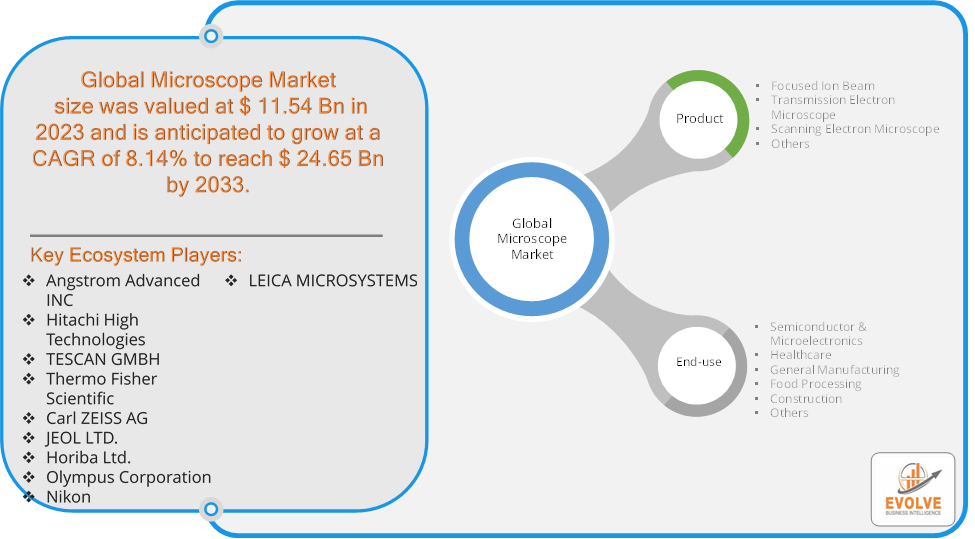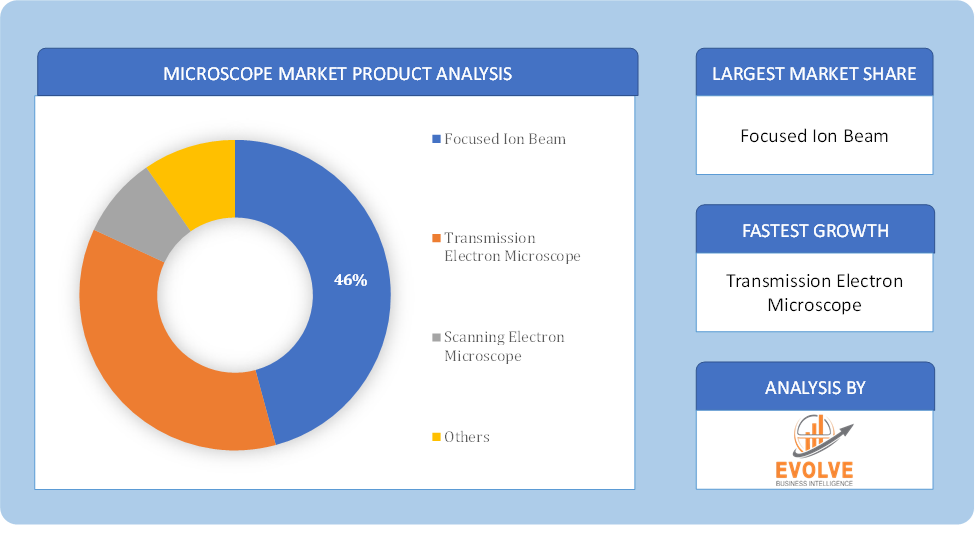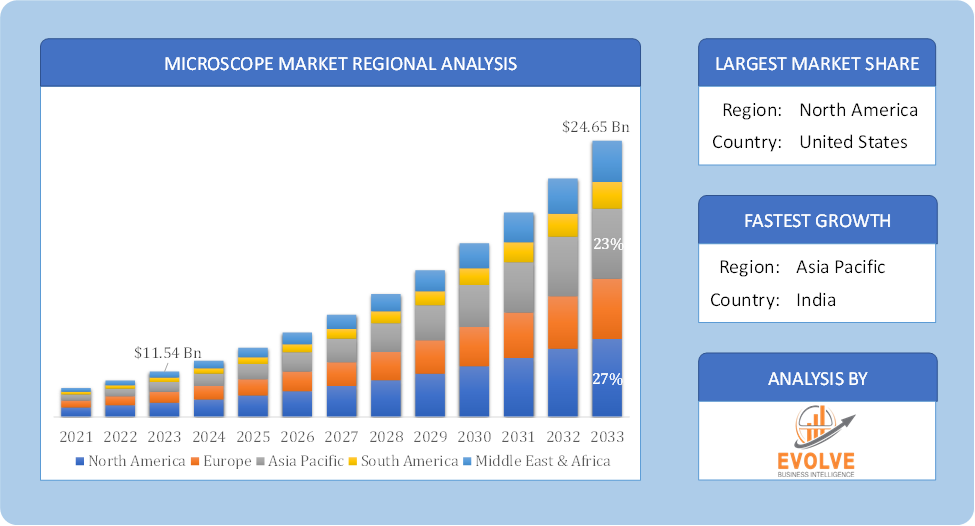Microscope Market Analysis and Global Forecast 2023-2033
$ 1,390.00 – $ 5,520.00Price range: $ 1,390.00 through $ 5,520.00
Microscope Market Research Report: Information By Product Type (Focused Ion Beam, Transmission Electron Microscope, Scanning Electron Microscope, Others), By End-use (Semiconductor & Microelectronics, Healthcare, General Manufacturing, Food Processing, Construction, Others), and by Region — Forecast till 2033
Page: 135
Microscope Market Overview
The Microscope Market Size is expected to reach USD 24.65 Billion by 2033. The Microscope industry size accounted for USD 11.54 Billion in 2023 and is expected to expand at a compound annual growth rate (CAGR) of 8.14% from 2023 to 2033. The microscope market focuses on the development and sale of various types of microscopes, including optical, electron, and scanning probe microscopes, used across industries such as life sciences, material sciences, and electronics. Driven by technological advancements and increased demand for high-resolution imaging, this market is expanding rapidly. Key growth factors include the rise in healthcare spending, increased research and development activities, and the growing need for precise diagnostic tools in medical and scientific research. The market is also influenced by trends in miniaturization and digitalization.
Global Microscope Market Synopsis
The COVID-19 pandemic has led to supply chain disruptions leading to supply shortages or lower demand in the Microscope market. The travel restrictions and social-distancing measures have resulted in a sharp drop in consumer and business spending and this pattern is to continue for some time. The end-user trend and preferences have changed due to the pandemic and have resulted in manufacturers, developers, and service providers adopting various strategies to stabilize the company.
Microscope Market Dynamics
The major factors that have impacted the growth of Microscope are as follows:
Drivers:
- Technological Advancements
Continuous innovations in microscopy technology, including the development of high-resolution imaging techniques, digital and automated microscopes, and the integration of artificial intelligence (AI), are significantly enhancing the capabilities of microscopes. These advancements are particularly impactful in fields like life sciences, where they enable detailed cellular and molecular analysis, and in materials science, where they allow for precise material characterization.
Restraint:
- Limited Access in Emerging Markets
Although there is growing demand for microscopy tools in emerging economies, access to these technologies remains limited due to factors like inadequate infrastructure, lower healthcare spending, and a lack of funding for scientific research. In regions where budgets are tight, the priority may be given to more immediate healthcare needs over investment in advanced diagnostic tools like high-end microscopes.
Opportunity:
⮚ Expansion of Digital and Automated Microscopy
The shift towards digital and automated microscopy offers significant opportunities for market growth. These technologies enhance imaging capabilities, improve accuracy, and reduce human error, making them attractive in both clinical and research settings. The integration of digital solutions, such as AI-powered image analysis and cloud-based data storage, is expected to revolutionize workflows in laboratories and medical facilities. This shift not only improves efficiency but also opens up new applications in areas like telepathology, where remote diagnosis is possible, allowing for broader accessibility and faster decision-making.
Microscope Segment Overview
Based on Product Type, the market is segmented based on Focused Ion Beam, Transmission Electron Microscope, Scanning Electron Microscope, Others. the Scanning Electron Microscope (SEM) segment dominates due to its versatility and wide application in materials science, biology, and industry. Transmission Electron Microscopes (TEM) also hold a significant share, particularly in high-resolution imaging for research and detailed structural analysis.
By End Use
Based on End Uses, the market has been divided into the Semiconductor & Microelectronics, Healthcare, General Manufacturing, Food Processing, Construction, Others. the Healthcare segment dominates due to its critical role in diagnostics, research, and medical imaging. The Semiconductor & Microelectronics segment also holds a significant share, driven by the need for high-resolution imaging in semiconductor manufacturing and materials analysis.
Global Microscope Market Regional Analysis
Based on region, the global Microscope market has been divided into North America, Europe, Asia-Pacific, the Middle East & Africa, and Latin America. North America is projected to dominate the use of the Microscope market followed by the Asia-Pacific and Europe regions.
 Microscope North America Market
Microscope North America Market
North America holds a dominant position in the Microscope Market. North America currently has a sizable share of the market for microscopy devices because of large investments made in research and development, which are anticipated to continue during the forecast period. The United States will continue to have the most market share in this area in North America.
Microscope Asia-Pacific Market
The Asia-Pacific region has indeed emerged as the fastest-growing market for the Microscope industry. The market for microscopy devices in Asia Pacific holds the second-largest share. This expansion is being fueled by the establishment of collaboration centers for microscopy research, an increase in R&D funding for microscopy, and a rise in the application of correlative microscopy in nanotechnology and biosciences research.
Competitive Landscape
The global Microscope market is highly competitive, with numerous players offering a wide range of software solutions. The competitive landscape is characterized by the presence of established companies, as well as emerging startups and niche players. To increase their market position and attract a wide consumer base, the businesses are employing various strategies, such as product launches, and strategic alliances.
Prominent Players:
- Angstrom Advanced INC
- Hitachi High Technologies
- TESCAN GMBH
- Thermo Fisher Scientific
- Carl ZEISS AG
- JEOL LTD.
- Horiba Ltd.
- Olympus Corporation
- Nikon
- LEICA MICROSYSTEMS
Key Development
March 2022 Scientists at Columbia University in New York City created a high-speed 3D microscope enabling real-time imaging within the living body to diagnose tumours and other disorders.
Scope of the Report
Global Microscope Market, by Product
- Focused Ion Beam
- Transmission Electron Microscope
- Scanning Electron Microscope
- Others
Global Microscope Market, by End-use
- Semiconductor & Microelectronics
- Healthcare
- General Manufacturing
- Food Processing
- Construction
- Others
Global Microscope Market, by Region
- North America
- US
- Canada
- Mexico
- Europe
- UK
- Germany
- France
- Italy
- Spain
- Benelux
- Nordic
- Rest of Europe
- Asia Pacific
- China
- Japan
- South Korea
- Indonesia
- Austalia
- Malaysia
- India
- Rest of Asia Pacific
- South America
- Brazil
- Argentina
- Rest of South America
- Middle East & Africa
- Saudi Arabia
- UAE
- Egypt
- South Africa
- Rest of Middle East & Africa
| Parameters | Indicators |
|---|---|
| Market Size | 2033: USD 24.65 Billion |
| CAGR (2023-2033) | 8.14% |
| Base year | 2022 |
| Forecast Period | 2023-2033 |
| Historical Data | 2021 (2017 to 2020 On Demand) |
| Report Coverage | Revenue Forecast, Competitive Landscape, Growth Factors, and Trends |
| Key Segmentations | Product Type, End Use |
| Geographies Covered | North America, Europe, Asia-Pacific, South America, Middle East, Africa |
| Key Vendors | Angstrom Advanced INC, Hitachi High Technologies, TESCAN GMBH, Thermo Fisher Scientific, Carl ZEISS AG, JEOL LTD., Horiba Ltd., Olympus Corporation, Nikon, LEICA MICROSYSTEMS. |
| Key Market Opportunities | · Growing adoption of the latest technologies |
| Key Market Drivers | · Rising expenditure across the microscopy field |
REPORT CONTENT BRIEF:
- High-level analysis of the current and future Microscope market trends and opportunities
- Detailed analysis of current market drivers, restraining factors, and opportunities in the future
- Microscope market historical market size for the year 2021, and forecast from 2023 to 2033
- Microscope market share analysis at each product level
- Competitor analysis with detailed insight into its product segment, Government & Defense strength, and strategies adopted.
- Identifies key strategies adopted including product launches and developments, mergers and acquisitions, joint ventures, collaborations, and partnerships as well as funding taken and investment done, among others.
- To identify and understand the various factors involved in the global Microscope market affected by the pandemic
- To provide a detailed insight into the major companies operating in the market. The profiling will include the Government & Defense health of the company’s past 2-3 years with segmental and regional revenue breakup, product offering, recent developments, SWOT analysis, and key strategies.
Frequently Asked Questions (FAQ)
What is the study period of this market?
The study period of the global Microscope market is 2021- 2033
What is the growth rate of the global Microscope market?
The global Microscope market is growing at a CAGR of 8.14% over the next 10 years
Which region has the highest growth rate in the market of Microscope?
Asia Pacific is expected to register the highest CAGR during 2023-2033
Which region has the largest share of the global Microscope market?
North America holds the largest share in 2022
Who are the key players in the global Microscope market?
Angstrom Advanced INC, Hitachi High Technologies, TESCAN GMBH, Thermo Fisher Scientific, Carl ZEISS AG, JEOL LTD., Horiba Ltd., Olympus Corporation, Nikon, and LEICA MICROSYSTEMS are the major companies operating in the market.
Do you offer Post Sale Support?
Yes, we offer 16 hours of analyst support to solve the queries
Do you sell particular sections of a report?
Yes, we provide regional as well as country-level reports. Other than this we also provide a sectional report. Please get in contact with our sales representatives.
Press Release

Global Pharmaceutical Manufacturing Market to Reach $1.38 Trillion by 2035 with 7.35% CAGR, New Research Shows

The Global Mammography Market Is Estimated To Record a CAGR of Around 10.29% During The Forecast Period

Glue Stick Market to Reach USD 2.35 Billion by 2034

Podiatry Service Market to Reach USD 11.88 Billion by 2034

Microfluidics Technology Market to Reach USD 32.58 Billion by 2034

Ferric Chloride Market to Reach USD 10.65 Billion by 2034

Family Practice EMR Software Market to Reach USD 21.52 Billion by 2034

Electric Hairbrush Market to Reach USD 15.95 Billion by 2034

Daily Bamboo Products Market to Reach USD 143.52 Billion by 2034

Cross-border E-commerce Logistics Market to Reach USD 112.65 Billion by 2034
Table of Content
Chapter 1. Executive Summary Chapter 2. Scope Of The Study 2.1. Market Definition 2.2. Scope Of The Study 2.2.1. Objectives of Report 2.2.2. Limitations 2.3. Market Structure Chapter 3. Evolve BI Methodology Chapter 4. Market Insights and Trends 4.1. Supply/ Value Chain Analysis 4.1.1. Raw End Uses Providers 4.1.2. Manufacturing Process 4.1.3. Distributors/Retailers 4.1.4. End-Use Industry 4.2. Porter’s Five Forces Analysis 4.2.1. Threat Of New Entrants 4.2.2. Bargaining Power Of Buyers 4.2.3. Bargaining Power Of Suppliers 4.2.4. Threat Of Substitutes 4.2.5. Industry Rivalry 4.3. Impact Of COVID-19 on the Microscope Market 4.3.1. Impact on Market Size 4.3.2. End-Use Industry Trend, Preferences, and Budget Impact 4.3.3. Regulatory Framework/Government Policies 4.3.4. Key Players' Strategy to Tackle Negative Impact 4.3.5. Opportunity Window 4.4. Technology Overview 12.28. Macro factor 4.6. Micro Factor 4.7. Demand Supply Gap Analysis of the Microscope Market 4.8. Import Analysis of the Microscope Market 4.9. Export Analysis of the Microscope Market Chapter 5. Market Dynamics 5.1. Introduction 5.2. DROC Analysis 5.2.1. Drivers 5.2.2. Restraints 5.2.3. Opportunities 5.2.4. Challenges 5.3. Patent Analysis 5.4. Industry Roadmap 5.5. Parent/Peer Market Analysis Chapter 6. Global Microscope Market, By Product Type 6.1. Introduction 6.2. Focused Ion Beam 6.3. Transmission Electron Microscope 6.4. Scanning Electron Microscope 6.5. Others Chapter 7. Global Microscope Market, By End Use 7.1. Introduction 7.2. Semiconductor & Microelectronics 7.3. Healthcare 7.4. General Manufacturing 7.5. Food Processing 7.6. Construction 7.7. Others Chapter 8. Global Microscope Market, By Region 8.1. Introduction 8.2. North America 8.2.1. Introduction 8.2.2. Driving Factors, Opportunity Analyzed, and Key Trends 8.2.3. Market Size and Forecast, By Country, 2023-2033 8.2.4. Market Size and Forecast, By Product Type, 2023-2033 8.2.5. Market Size and Forecast, By End Use, 2023-2033 8.2.6. US 8.2.6.1. Introduction 8.2.6.2. Driving Factors, Opportunity Analyzed, and Key Trends 8.2.6.3. Market Size and Forecast, By Product Type, 2023-2033 8.2.6.4. Market Size and Forecast, By End Use, 2023-2033 8.2.7. Canada 8.2.7.1. Introduction 8.2.7.2. Driving Factors, Opportunity Analyzed, and Key Trends 8.2.7.4. Market Size and Forecast, By Product Type, 2023-2033 8.2.7.5. Market Size and Forecast, By End Use, 2023-2033 8.3. Europe 8.3.1. Introduction 8.3.2. Driving Factors, Opportunity Analyzed, and Key Trends 8.3.3. Market Size and Forecast, By Country, 2023-2033 8.3.4. Market Size and Forecast, By Product Type, 2023-2033 8.3.5. Market Size and Forecast, By End Use, 2023-2033 8.3.6. Germany 8.3.6.1. Introduction 8.3.6.2. Driving Factors, Opportunity Analyzed, and Key Trends 8.3.6.3. Market Size and Forecast, By Product Type, 2023-2033 8.3.6.4. Market Size and Forecast, By End Use, 2023-2033 8.3.7. France 8.3.7.1. Introduction 8.3.7.2. Driving Factors, Opportunity Analyzed, and Key Trends 8.3.7.3. Market Size and Forecast, By Product Type, 2023-2033 8.3.7.4. Market Size and Forecast, By End Use, 2023-2033 8.3.8. UK 8.3.8.1. Introduction 8.3.8.2. Driving Factors, Opportunity Analyzed, and Key Trends 8.3.8.3. Market Size and Forecast, By Product Type, 2023-2033 8.3.8.4. Market Size and Forecast, By End Use, 2023-2033 8.3.9. Italy 8.3.9.1. Introduction 8.3.9.2. Driving Factors, Opportunity Analyzed, and Key Trends 8.3.9.3. Market Size and Forecast, By Product Type, 2023-2033 8.3.9.4. Market Size and Forecast, By End Use, 2023-2033 8.3.11. Rest Of Europe 8.3.11.1. Introduction 8.3.11.2. Driving Factors, Opportunity Analyzed, and Key Trends 8.3.11.3. Market Size and Forecast, By Product Type, 2023-2033 8.3.11.4. Market Size and Forecast, By End Use, 2023-2033 8.4. Asia-Pacific 8.4.1. Introduction 8.4.2. Driving Factors, Opportunity Analyzed, and Key Trends 8.4.3. Market Size and Forecast, By Country, 2023-2033 8.4.4. Market Size and Forecast, By Product Type, 2023-2033 8.12.28. Market Size and Forecast, By End Use, 2023-2033 8.4.6. China 8.4.6.1. Introduction 8.4.6.2. Driving Factors, Opportunity Analyzed, and Key Trends 8.4.6.3. Market Size and Forecast, By Product Type, 2023-2033 8.4.6.4. Market Size and Forecast, By End Use, 2023-2033 8.4.7. India 8.4.7.1. Introduction 8.4.7.2. Driving Factors, Opportunity Analyzed, and Key Trends 8.4.7.3. Market Size and Forecast, By Product Type, 2023-2033 8.4.7.4. Market Size and Forecast, By End Use, 2023-2033 8.4.8. Japan 8.4.8.1. Introduction 8.4.8.2. Driving Factors, Opportunity Analyzed, and Key Trends 8.4.8.3. Market Size and Forecast, By Product Type, 2023-2033 8.4.8.4. Market Size and Forecast, By End Use, 2023-2033 8.4.9. South Korea 8.4.9.1. Introduction 8.4.9.2. Driving Factors, Opportunity Analyzed, and Key Trends 8.4.9.3. Market Size and Forecast, By Product Type, 2023-2033 8.4.9.4. Market Size and Forecast, By End Use, 2023-2033 8.4.10. Rest Of Asia-Pacific 8.4.10.1. Introduction 8.4.10.2. Driving Factors, Opportunity Analyzed, and Key Trends 8.4.10.3. Market Size and Forecast, By Product Type, 2023-2033 8.4.10.4. Market Size and Forecast, By End Use, 2023-2033 8.5. Rest Of The World (RoW) 8.5.1. Introduction 8.5.2. Driving Factors, Opportunity Analyzed, and Key Trends 8.5.3. Market Size and Forecast, By Product Type, 2023-2033 8.5.4. Market Size and Forecast, By End Use, 2023-2033 Chapter 9. Company Landscape 9.1. Introduction 9.2. Vendor Share Analysis 9.3. Key Development Analysis 9.4. Competitor Dashboard Chapter 10. Company Profiles 10.1. Angstrom Advanced INC 10.1.1. Business Overview 10.1.2. Government & Defense Analysis 10.1.2.1. Government & Defense – Existing/Funding 10.1.3. Product Portfolio 10.1.4. Recent Development and Strategies Adopted 10.1.5. SWOT Analysis 10.2. Hitachi High Technologies 10.2.1. Business Overview 10.2.2. Government & Defense Analysis 10.2.2.1. Government & Defense – Existing/Funding 10.2.3. Product Portfolio 10.2.4. Recent Development and Strategies Adopted 10.2.5. SWOT Analysis 10.3. TESCAN GMBH 10.3.1. Business Overview 10.3.2. Government & Defense Analysis 10.3.2.1. Government & Defense – Existing/Funding 10.3.3. Product Portfolio 10.3.4. Recent Development and Strategies Adopted 10.3.5. SWOT Analysis 10.4. Thermo Fisher Scientific 10.4.1. Business Overview 10.4.2. Government & Defense Analysis 10.4.2.1. Government & Defense – Existing/Funding 10.4.3. Product Portfolio 10.4.4. Recent Development and Strategies Adopted 10.12.28. SWOT Analysis 10.5. Carl ZEISS AG 10.5.1. Business Overview 10.5.2. Government & Defense Analysis 10.5.2.1. Government & Defense – Existing/Funding 10.5.3. Product Portfolio 10.5.4. Recent Development and Strategies Adopted 10.5.5. SWOT Analysis 10.6. JEOL LTD. 10.6.1. Business Overview 10.6.2. Government & Defense Analysis 10.6.2.1. Government & Defense – Existing/Funding 10.6.3. Product Portfolio 10.6.4. Recent Development and Strategies Adopted 10.6.5. SWOT Analysis 10.7. Horiba Ltd. 10.7.1. Business Overview 10.7.2. Government & Defense Analysis 10.7.2.1. Government & Defense – Existing/Funding 10.7.3. Product Portfolio 10.7.4. Recent Development and Strategies Adopted 10.7.5. SWOT Analysis 10.8 Olympus Corporation 10.8.1. Business Overview 10.8.2. Government & Defense Analysis 10.8.2.1. Government & Defense – Existing/Funding 10.8.3. Product Portfolio 10.8.4. Recent Development and Strategies Adopted 10.8.5. SWOT Analysis 10.9 Nikon 10.9.1. Business Overview 10.9.2. Government & Defense Analysis 10.9.2.1. Government & Defense – Existing/Funding 10.9.3. Product Portfolio 10.9.4. Recent Development and Strategies Adopted 10.9.5. SWOT Analysis 10.10. LEICA MICROSYSTEMS 10.10.1. Business Overview 10.10.2. Government & Defense Analysis 10.10.2.1. Government & Defense – Existing/Funding 10.10.3. Product Portfolio 10.10.4. Recent Development and Strategies Adopted 10.10.5. SWOT Analysis
Connect to Analyst
Research Methodology










